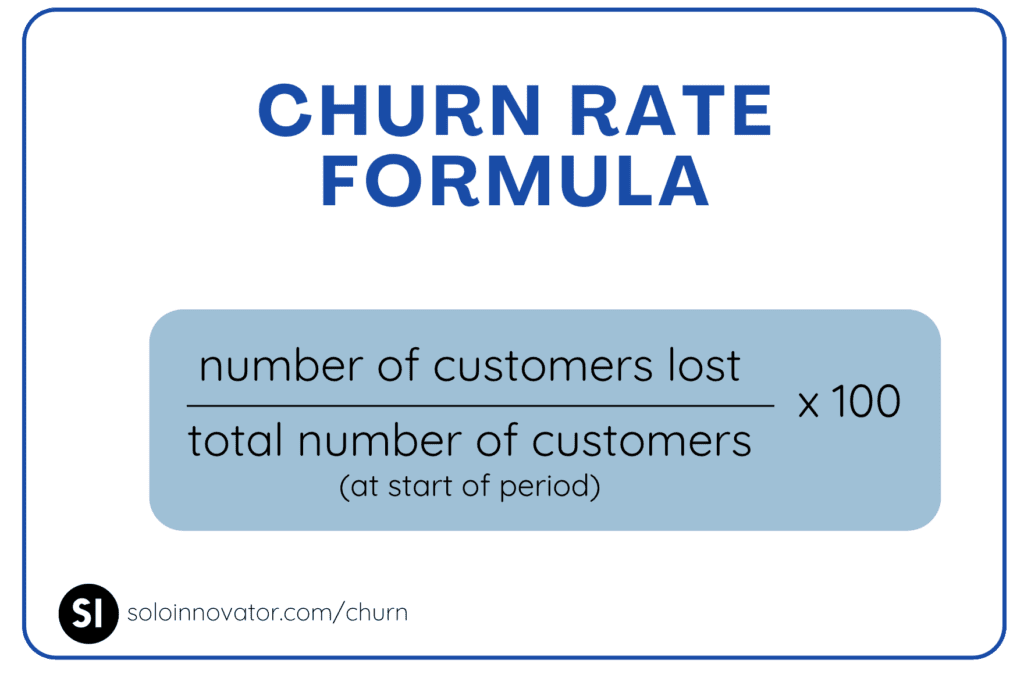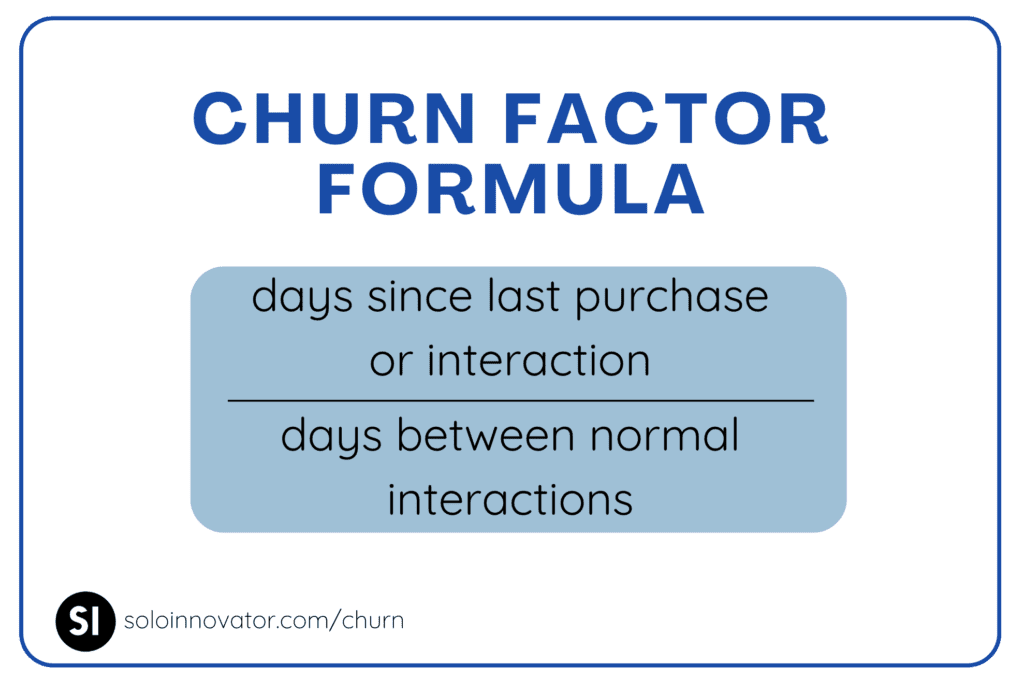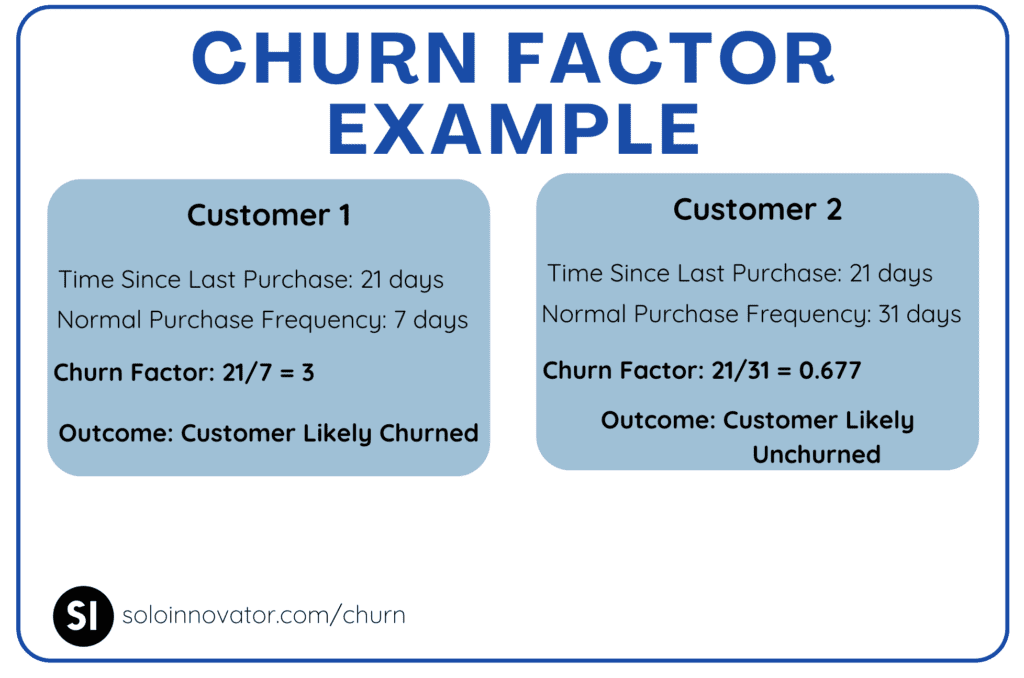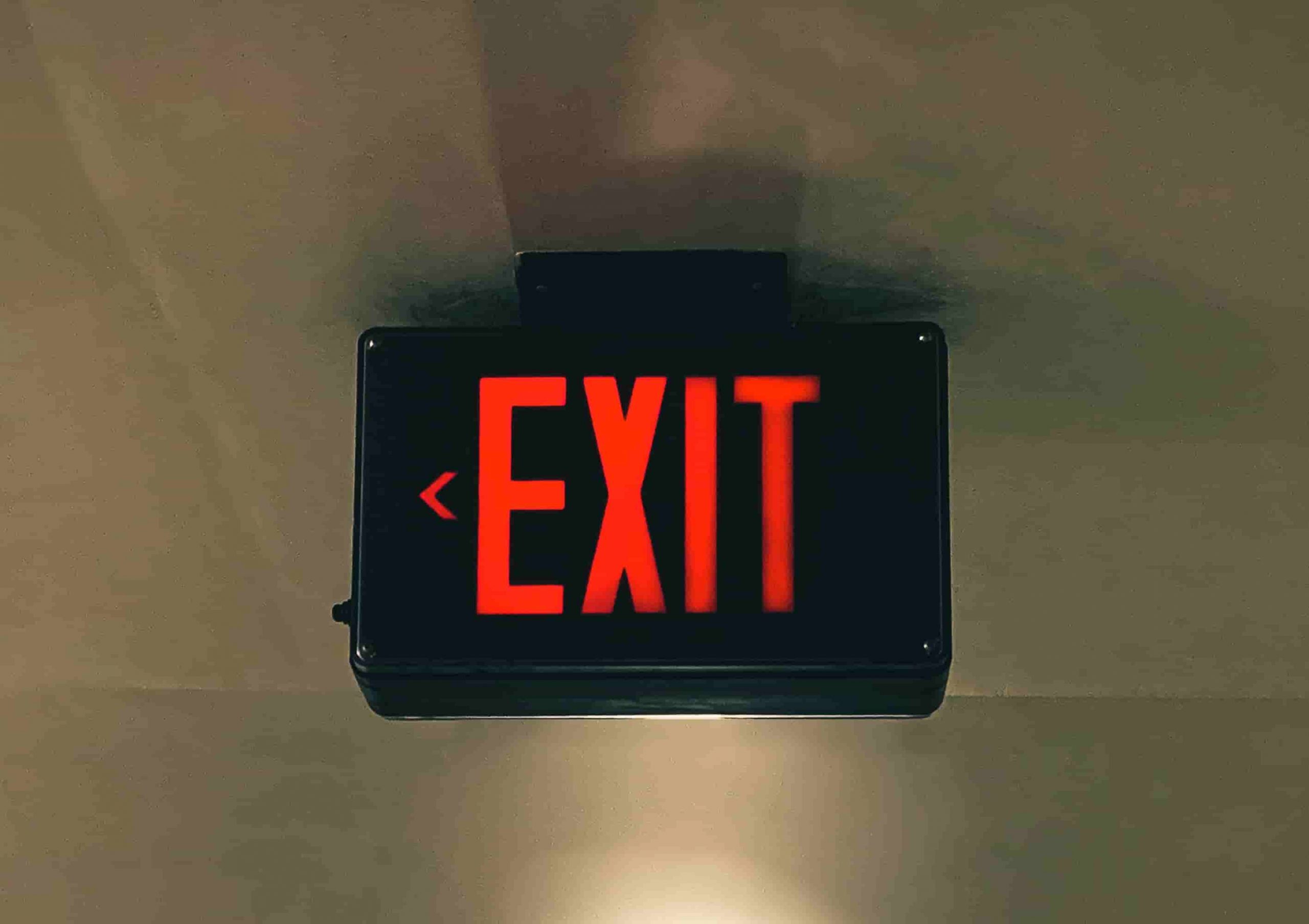How Can I Reduce Customer Churn?
As business founders, you and I both know that customer churn sucks.
When you’ve spent lots of time and/or money getting a customer to buy from your business, it’s so disheartening to see them leave.
While it’s (sadly) impossible to completely remove churn from your business, there are ways to reduce it.
In this article, we’re going to have a look at how you can identify, predict and reduce churn in your business.
If you’re more of a watcher than a reader, check out Dan Martell’s experience of reducing customer churn before you get into this article.
What is Customer Churn?
Customer churn is the rate at which customers stop paying for the services offered by a company.
It’s a valuable metric to measure customer loyalty and retention.
How Do I Calculate Customer Churn Rate?

You can calculate the churn rate by dividing the total number of customers lost by the number of customers you started within a given period.
For example, if you start your month with 500 customers and end with 450, your churn rate is 10% because 50 customers (500-450) left your business, meaning that 10% (50/500 * 100) left your business.
What are the 2 Types of Customer Churn?
There are 2 main types of churn that impact SaaS businesses:
- Revenue Churn: The percentage of your monthly recurring revenue (MRR) that you lose in a given month
- Customer Churn: The percentage of customers that you lose in a given month
While both types of churn are important to monitor, as they both impact the health of your business’ growth, revenue churn is by far the most important as it has the most impact on your business.
Why Is Churn Important To Your Business?
In my experience, churn is one of the most crucial metrics for your business.
I’ve found that if your customer churn rate is too high, your business is likely to also have issues with:
- Revenue: When lots of customers cancel subscriptions with your business, they stop generating revenue, which is obviously a huge problem.
- Sustainability: High churn rates can make it challenging for a business to sustain itself or grow
- Customer Satisfaction: High churn rates normally indicate that customers aren’t satisfied with your product. If you don’t address the problem soon, it’s likely even more will leave.
- Investor Confidence: If your business has been invested in, investors may be worried about your performance.
Why Do Customers Churn?
Before we get into understanding how we can reduce churn, it’s important to understand why customers might be churning from your business.
I’ve generally found that customers churn for one of the following reasons:
Your Customers Aren’t The Right Fit For Your Business
One of the most common reasons that I see businesses fail is because they target the wrong audience.
If you often hear customers mention that the product isn’t meeting their needs, it’s probably worth taking some time to reassess the audience your targeting.
Your Customers Aren’t Achieving Their Goals
It’s crucial to understand and address any gaps between your customers’ expectations and the actual results they achieve with your product.
You should conduct thorough customer feedback analysis, gather insights, and identify areas where your product can be improved to better meet their needs and deliver the desired outcomes.
You Don’t Support Your Customers Enough
While having a great product will draw customers in, if they don’t have the right support to use it effectively, they will quickly churn.
If your customers feel that your support is lacking or unresponsive, it’s important to invest in improving your support channels, response times, and overall customer service experience.
This doesn’t just mean sitting at the end of a phone for hours though! Creating in-depth FAQ pages and more in-depth and targetted onboarding processes reduce support burden and help users find answers to their questions even quicker.
Your Competitors Suit The Customer Better
If your customers perceive your competitors as offering superior products or services, it’s crucial to assess and understand the reasons behind this perception.
Conduct a competitive analysis to identify areas where you can differentiate and improve your product and focus on enhancing your unique value proposition, addressing customer pain points, and consistently showcasing the benefits and advantages of choosing your product over competitors.
You’ve Got a Poor Product
Obvious answer here, but if your product’s poor, there’s no way your customers are going to stick around.
Make sure that when you launch, your product is robust and clearly meets your target audience’s needs.
Price
Pricing can significantly impact customer perception.
If customers believe your product is too expensive, you may need to justify the pricing by highlighting the unique value, features, and benefits it offers.
Alternatively, if customers perceive your product as too cheap, you might consider adjusting the pricing to reflect its value accurately. It’s a really hard balance to strike, which is why I’ve created a complete guide to setting your pricing strategy, which you can check out here.
What’s a Healthy Level of Churn?

While we can all agree that it would be ideal to have no churn in our businesses, some level of churn is of course inevitable.
Generally, I aim for a churn rate of under 5% per month as I’ve found this to be a healthy upper limit. Of course, your target churn rate depends on the type of business you’re running. If you own a Christmas gingerbread house subscription business, for instance, you’ll probably see a sudden increase in churn rates in January.
Churn rate doesn’t have to be very high at all to make your business unsustainable. If your churn rate is just 9% per month, you’re losing almost all your customers in a year.
This can be catastrophic for your business, even if you have the most efficient marketing pipeline. Replacing your entire customer base every year is not feasible long-term, and it will require significant investment in marketing and sales to maintain growth.
Focus on Customer Churn Predictability Too
While the amount of churn that your business experiences is obviously important (if you’re churning 50% of your customers in a single month, there’s definitely something you need to address), I’d argue that churn predictability is more important.
From my experience, if your churn rate varies wildly from month to month, with no easily explainable reason, you’re probably in trouble (maybe even more trouble than a consistently high churn rate).
Why?
Because it makes it incredibly difficult to plan and forecast, meaning you’re more likely to spend more than a customer is worth acquiring through your sales pipeline.
So now we know how important churn predictability is, let’s look at how you can actually predict customer churn.
How To Predict Customer Churn – Churn Factor
Luckily, predicting which customers are likely to churn isn’t too difficult
I’ve found that Churn Factor to be a great metric for this, as it measures how likely a customer is to churn based on how often they engage with your product.

Calculating the churn factor is easy too, simply divide the days since a specific customer’s last interaction by the number of days that a customer normally interacts. If the churn factor is over 1, the customer is at risk of churning, so it’s worth reaching out to try and keep the business.
For example, if a customer normally buys a product from your business every 7 days and has not placed an order in 21 days they will likely become a churn, whereas a customer who hasn’t placed an order in 21 days, but normally places an order every month is unlikely to have churned. See the example below for proof.

What is Segmenting Churn?
Segmenting churn is the process of analysing churn by grouping customers in different ways.
This approach allows you to gain a more in-depth understanding of exactly why customers are churning from your business.
The categories that you choose to segment your customers into largely depend on your business structure, but I’ve found that segmenting your customers by their pricing tier, customer type and the age of their account is a solid place to start if you’re unsure.
How Can I Reduce Churn?
So, by now you should be able to identify churn and predict which customers will churn, so let’s look at the most important phase. How to stop customers churning in the first place!
The best way to do this is simple. When customers churn, email them asking for the reasons why they’re leaving – if it’s a simple problem, you may be able to fix it for them on the spot and keep your customer. If they’re set on leaving anyway, at least you’ve got data.
After a few customers have left, you should start to see a pattern of the common reasons that are causing churn. These need to be the first things you work on fixing.
While I’d definitely recommend doing this if you’d like to reduce your churn, sometimes there’s no time to do a full analysis of the reason customers are churning. If a large proportion of your customers have suddenly churned, have a look at my top 5 most common reasons why customers churn, and see if anything resonates with your business.
Make Sure Your Product Fits The Market
If your product is in the early stages of release and you’re seeing high churn, it might be because your product doesn’t quite fit the market that you’re trying to penetrate.
This can be an incredibly difficult situation to get out of.
Your best bet is to try and gather feedback from users who have churned to identify what your product could do better to meet their needs.
If your product is having this issue, check out our guide to identifying the needs of your audience and creating an effective marketing plan.
Improve Your Onboarding Process
Onboarding is the process of introducing new customers to your product and helping them get setup.
A smooth onboarding process can significantly improve a customer’s perception of your product which can increase their retention, reducing churn. A great onboarding process:
- Gets a user setup on the system quickly
- Guides a user on how to perform the tasks that they are looking to do (not just a general site overview)
- Sends a follow-up email after a few hours/days to get the user to return to the service
If you have no onboarding process, you’ve not focused on it for a while, or it’s not targeted to individual groups of your customers, you should take a look at improving it to help your customers get up to speed with your product faster.
Improve Your Features
If a lot of your users are complaining that a certain feature isn’t included in your product, or isn’t quite right, you should prioritise implementing that change.
While you don’t necessarily need to implement every change that your users suggest, if a feature request comes up a lot, it’s probably worth a fix.
Improve Your Design
If your product has poor design that makes it difficult for your customers to use your application, it can lead to them getting frustrated and churning from your product. Look out for the following signs to see if your site needs a UX update:
- Difficult to Use: If your service is difficult to use, customers may become frustrated and switch to a competitor that offers a better user experience
- Confusing Navigation: If it’s difficult for customers to find what they’re looking for on your product, they may become frustrated and churn from your app
- Poor Design: In this modern age, appealing and user-friendly designs are critical for getting users to interact with your product
- Slow Load Times: If your service takes ages to load, customers may chose to not use your service and switch to one of your competitors
What is Net Negative Churn?
Unlike churn, net negative churn is incredibly beneficial to your business. Net negative churn refers to the situation where a business’s revenue from existing customers grows faster than the revenue lost from customers who have churned or downgraded their plans (i.e. a company is getting more revenue from its existing customers than it’s losing from churn).
This generally only happens for businesses that have subscription-based pricing (such as SaaSs) where existing customers upgrade their subscriptions at a higher rate than customers who leave. Net negative churn rate results in overall revenue growth, even if the company is losing customers which is overall more beneficial for the company.
FAQs
What is Customer Churn Analysis?
Customer churn analysis is a process of understanding why customers churn in a business.Customer churn analysis helps businesses make informed decisions and implement strategies to reduce churn rates, improve customer retention, and ultimately enhance their overall profitability and sustainability.
How Do I Predict Customer Churn?
Customer churn can be predicted by using the churn factor calculation. You can learn more about this here.
Key Takeaways
- Customer churn is the rate at which customers stop using a company’s services, a critical metric for assessing customer loyalty.
- Calculate churn rate by dividing the lost customers by the starting number in a given period (expressed as a percentage).
- Two main types of churn: Revenue Churn (loss of monthly revenue) and Customer Churn (loss of customers), with revenue churn often more impactful.
- High churn can lead to issues like revenue loss, sustainability problems, lower customer satisfaction, and investor concerns.
- Common reasons for churn include misalignment with the target audience, unmet goals, inadequate support, competition, product quality, and pricing issues.
- Aim for a healthy churn rate, typically below 5% per month, though it can vary by business type and industry.
- Predicting churn and ensuring predictability is crucial for effective planning and forecasting.
- Use the churn factor to predict churn based on customer engagement; a factor over 1 indicates risk of churn.
- Segmenting customers by factors like pricing tier, customer type, and account age helps understand why they leave.
- To reduce churn, gather feedback, fix issues, ensure product-market fit, improve onboarding, enhance features, and focus on good design.
- Net negative churn occurs in subscription businesses when revenue from existing customers grows faster than revenue lost from churned customers, leading to overall growth.
- Identifying and reducing churn is essential for long-term business growth and sustainability.
Overview
Now that you are able to identify and reduce churn in your business, check out our guide to scaling your startup to a multi-million dollar business, or see the 40 things you need to do before launching your product.







